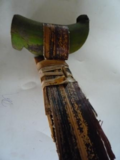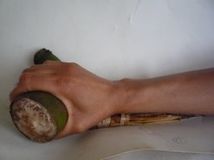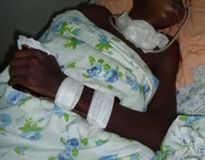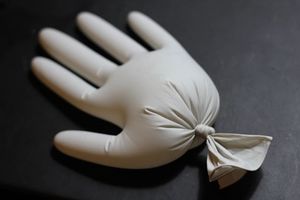Management of Traumatic Brain Injury in Low Resourced Settings
Original Editor - Add a link to your Physiopedia profile here.
Top Contributors - Naomi O'Reilly, Kim Jackson, Admin, Rachael Lowe, Eugenie Lamprecht, Uchechukwu Chukwuemeka, Jess Bell and Tony Lowe
Introduction[edit | edit source]
Countries can be categorised by their Gross National Income (GNI) (Previously known as the Gross National Product (GNP)). Gross national income is a measurement of a country's income. It includes all the income earned by a country's residents and businesses, including any income earned abroad.
Countries are classified into four categories. High-income countries, Upper-middle-income countries, Lower-middle income countries and low-income countries. Thresholds determined by the World Bank Data for July 2019 are as follows:
| Category | Gross National Income Per Capita ($US) |
|---|---|
| High Income | > $12,375 |
| Upper-Middle Income | $3,996 - $12,375 |
| Lower-Middle Income | $1,026 - $3,995 |
| Low Income | < $1,025 |
According to World Bank Data for the fiscal year 2020, 31 countries have been identified as low-income countries. https://datahelpdesk.worldbank.org/knowledgebase/articles/906519 These are:
| World Bank Region | Countries |
|---|---|
| Latin America & Carribean | Haiti |
| Europe & Central Asia | Tajikistan |
| Middle East & North Africa | Syrian Arab Republic |
| Sub Saharan Africa | Benin, Burkina Faso, Central African Republic, Chad, Democratic Republic of Congo, Eritrea, Ethiopia, The Gambia, Guinea, Guinea-Bissau, Mali, Mozambique, Niger, Rwanda, Sierra Leone, Somalia, South Sudan, Tanzania, Togo, Uganda |
| South Asia | Afghanistan |
| East Asia & Pacific | Korea Democratic People Republic |
Epidemiology of Traumatic Brain Injuries in Low Income Countries[edit | edit source]
The WHO estimates that almost 90% of the global deaths caused by injuries occur in low- and middle-income countries (LMICs). Traumatic Brain Injury is the main cause of one-third to one-half of these trauma related deaths and represents the greatest cause of death and disability globally among all trauma-related injuries. [1]
Road Traffic Injuries (RTI) are strongly connected to the global incidence of traumatic brain injury and give reason to why the LMICs experience nearly 3 times as many cases of traumatic brain injury proportionally than high-income countries (HICs). According to Laccarino’s epidemiological study, the proportion of traumatic brain injuries resulting from road traffic collisions was greatest in Africa and Southeast Asia (both 56%) and lowest in North America (25%). [1]
Interestingly a study carried out in 2009 comparing traumatic brain injury in 46 countries identified that whereas people were over twice as likely to die after severe traumatic brain injury in LMIC, there was half the likelihood of being disabled after mild and moderate traumatic brain injury. [2] The reasons for this were suggested to be socio-cultural (the culture has a different definition on what is defined as disabled) and environmental (e.g. the increased availability of informal carers).
Management of Traumatic Brain Injuries in Low income countries[edit | edit source]
Due to a scarcity of neurosurgical personnel, as is common in low income countries , it is important all health professionals should be aware of the assessment procedures for newly admitted traumatic brain injury patients and able to identify patients who may require urgent review or referral. A study done in Malawi suggested that monitoring changes in the Glasgow Coma Scale (GCS) and heart rate correlated strongly with mortality and therefore could effectively be used for triage of critically ill patients with traumatic brain injury.[3] A similar conclusion was made in a study by Subaiya that found advanced age, GCS, pupil reactivity, the presence of a major extracranial injury and time from injury to presentation to be predictors for intracranial hemorrhage (ICH) in traumatic brain injury patients from LMIC.[4]
A study done in Rwanda recognised that, due to limited resources for both hospital and patients bearing costs, the current guidelines for traumatic brain injury as promoted in high-income countries, were not suitable to be followed. The authors therefore recommended a predictive model should be used to allocate resources by demonstrated need.[5] These findings are important to be recognised by physiotherapists working in LMIC as similar strategies may need to be implemented with the allocation of rehabilitation input and equipment. For example, as much as a several-month intense physiotherapy programme may be ideal for restoring good movement patterns, a compensatory approach and early discharge may be appropriate if the family are selling land to afford the hospital admission and live a distance from a health facility.
Locally Made Resources[edit | edit source]
Equipment and appliances for management of impairments and functional limitations can be limited in supply and expensive in cost in LMICs and therefore alternatives may sometimes be required.
Bubble Peep[edit | edit source]
A simple positive expiratory pressure device can be made to help patients with decrease lung volume or sputum retention. Instructions can be found here: https://www.cincinnatichildrens.org/health/b/Bubble-PEP
Foam Splints[edit | edit source]
Foam mattresses are readily available in low income countries and can be utilised to make simple splits for both prevention and correction of contractures.
Cardboard Splints[edit | edit source]
For patients with mild or moderate tone, cardboard can be used if necessary to make resting splints.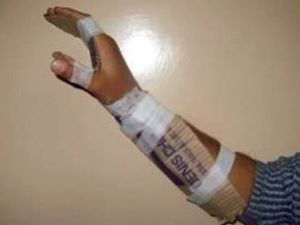
Banana Plant Splints[edit | edit source]
Water Filled Gloves[edit | edit source]
A latex glove filled with water and used to help position the patient to avoid pressure sores is a long used adjunct in pressure sore management in low resource settings. There is some debate as to whether they succeed or not in their objective [7] and further research in this area would be beneficial.Further ideas, particularly for children although some could be adapted for adults, can be found in the book “Disabled Village Children” by David Werner https://www.dinf.ne.jp/doc/english/global/david/dwe002/dwe00258.html#introduction3
Community Based Rehabilitation[edit | edit source]
The World Health Organisation has recognised the benefit of Community Based Rehabilitation (CBR) for people with disabilities in LMIC. A systematic review carried out by Iemmi in 2015 found moderate to high evidence that CBR is beneficial to people with physical disabilities although none of the studies had looked specifically at Traumatic Brain Injuries.
CBR is implemented along the following four principles as agreed upon during the CBR review of 2004:
- Participation
- Inclusion
- Sustainability
- Self-advocacy
However, before the CBR review of 2004 practitioners considered the following as the CBR principles and these are still considered relevant and clear to the practitioners.
Equality[edit | edit source]
The principle states that human beings are: All born equal, entitled to equal rights and should share the same responsibilities. It is important to note each develops as a unique individual with different abilities. These differences do not make us unequal in worth. It is important to differentiate ‘being’ and ‘doing’ when applying that principle. The principle helps in fighting prejudice against people with a disability.
Dignity[edit | edit source]
Dignity is the quality that deserves or earns respect. It is possible when society;
- Recognizes that all human beings have equal rights and worth;
- People are willing to share the available resources in order to promote their self-esteem;
- Recognizes the principle of full participation in societal activities.
Social Justice[edit | edit source]
The principle emphasises that services and opportunities are for all people and not for a numerically small group among them. The principle emphasises the importance of equalisation of opportunities and promotes the vision of positive discrimination and affirmative action.
Inclusion[edit | edit source]
The state of being included within a group or structure - persons with disabilities must be included in every aspect. Mainstreaming - disability must be mainstreamed in all programmes. Consider disability issues/persons with disabilities at all programme levels; planning, implementation, monitoring and evaluation.
Use of Locally Available Resources[edit | edit source]
For sustainability, CBR promotes the use of locally available resources as these will be affordable and available as they are found within that particular locality. This also includes the human resource that is; the involvement and training local people as CBR workers as they live within that community.
Empowerment[edit | edit source]
To empower is to make someone stronger and confident, especially in controlling their life and claiming / advocating for their rights. Persons with disabilities understanding that they alone, along with others, have the power to change a situation if they so wish.
Solidarity[edit | edit source]
Solidarity is unity or agreement of feeling or actions especially among vulnerable groups, with the purpose of emphasising that human life is shared by all. Solidarity that fosters human life should be seen as a privilege of all but not charity for some. It should therefore be shown among those who are dependent and need help e.g. the PWDs, the children and the elderly. Solidarity is one of the main principles of society without which there would be no survival. (WHO, 2004)
Prevention of Traumatic Brain Injuries from Road Traffic Accidents[edit | edit source]
A significant way to reduce the impact of Traumatic Brain Injuries is Road Safety initiatives and physiotherapists in low income countries are ideally placed to be at the forefront of developing, promoting and supporting these health promotion activities. In many low-income countries motorcycles are used to provide public transport. These commercial riders may not have licences and if they do they are often given without licences without proper road training. Helmet wearing is often viewed as optional by the riders even if there is legislation for their use. A study done in an urban setting in Uganda showed only 18% of riders wearing helmets. (Kamulegeya, 2015), it is expected that the percentage would be lower in rural settings where there is less police presence. Below are a few examples of initiatives working to reduce accidents and injuries caused by motorcycle riding:
Awareness drive on Road Safety, School of Physiotherapy, D Y Patil University, Indiahttp://www.dypatil.edu/schools/physiotherapy/awareness-drive-on-road-safety/
Resources[edit | edit source]
Ramesh A, Fezeu F, Fidele B, Ngulde SI, Moosa S, Gress D, Calland JF, Petroze R, Young JS, Nkusi AE, Muneza S. Challenges and solutions for traumatic brain injury management in a resource-limited environment: example of a public referral hospital in Rwanda . Cureus. 2014 May 9;6(5):e179.
Rubiano AM, Puyana JC, Mock CN, Bullock MR, Adelson PD: Strengthening neurotrauma care systems in low and middle income countries. Brain Inj 2013, 27:262-72.
Harris, O. A., Bruce, C. A., Reid, M., Cheeks, R., Easley, K., Surles, M. C., Pan, Yi., Rhoden-Salmon, D., Webster, D., and Crandon, I. (2008). Examination of the management of traumatic brain injury in the developing and developed world: focus on resource utilization, protocols, and practices that alter outcome. Journal of Neurosurgery JNS 109, 3, 433-438
Bashford T, Clarkson PJ, Menon DK, Hutchinson PJ. Unpicking the Gordian knot: a systems approach to traumatic brain injury care in low-income and middle-income countries. BMJ global health. 2018 Mar 1;3(2):e000768.
Tran TM, Fuller AT, Kiryabwire J, Mukasa J, Muhumuza M, Ssenyojo H, Haglund MM. Distribution and characteristics of severe traumatic brain injury at Mulago National Referral Hospital in Uganda. World neurosurgery. 2015 Mar 1;83(3):269-77.
Hyder AA, Wunderlich CA, Puvanachandra P, Gururaj G, Kobusingye OC. The impact of traumatic brain injuries: a global perspective. NeuroRehabilitation. 2007 Jan 1;22(5):341-53.
Prasad GL, Anmol N, Menon GR. Outcome of traumatic brain injury in the elderly population: a tertiary center experience in a developing country. World neurosurgery. 2018 Mar 1;111:e228-34.
References[edit | edit source]
- ↑ 1.0 1.1 Laccarino, C., Carretta, A., Nicolosi, F. and Morselli, C., 2018. Epidemiology of severe traumatic brain injury. Journal of neurosurgical sciences, 62(5), pp.535-541
- ↑ De Silva, M.J., Roberts, I., Perel, P., Edwards, P., Kenward, M.G., Fernandes, J., Shakur, H. and Patel, V., 2008. Patient outcome after traumatic brain injury in high-, middle-and low-income countries: analysis of data on 8927 patients in 46 countries. International journal of epidemiology, 38(2), pp.452-458.
- ↑ Qureshi J S, Ohm R, Rajala H, Mabedi C, Sadr-Azodi O, Andren-Sandberg A, Charles A G, 2013, Head injury triage in a sub Saharan African urban population, International Journal of Surgery, 11 (3) 265-269
- ↑ Subaiya, S., Roberts, I., Komolafe, E. and Perel, P., 2012. Predicting intracranial hemorrhage after traumatic brain injury in low and middle-income countries: A prognostic model based on a large, multi-center, international cohort. BMC emergency medicine, 12(1), p.17.
- ↑ Ramesh, A., Fezeu, F., Fidele, B., Ngulde, S.I., Moosa, S., Gress, D., Calland, J.F., Petroze, R., Young, J.S., Nkusi, A.E. and Muneza, S., 2014. Challenges and solutions for traumatic brain injury management in a resource-limited environment: example of a public referral hospital in Rwanda. Cureus, 6(5), p.e179
- ↑ Procter F. Rehabilitation of the burn patient. Indian journal of plastic surgery: official publication of the Association of Plastic Surgeons of India. 2010 Sep;43(Suppl):S101. Available from: https://www.ncbi.nlm.nih.gov/pmc/articles/PMC3038404/ (Accessed 30/09/2019)
- ↑ nursemathmedblog. Using Water-Filled Latex Gloves to Prevent Heel Ulcer: Good or Bad Practice?. Available from: http://URLofelectronicpublication (accessed 30/09/2019)
- ↑ Physiopedia. Safe Boda - Uganda. Available from: http://www.youtube.com/watch?v=w9-CHAIdBx8[last accessed 30/10/17]
- ↑ Physiopedia. Vietnam Helmet Wearing Coalition. Available from: http://www.youtube.com/watch?v=JJvMo8OM3Ig[last accessed 30/10/17]
